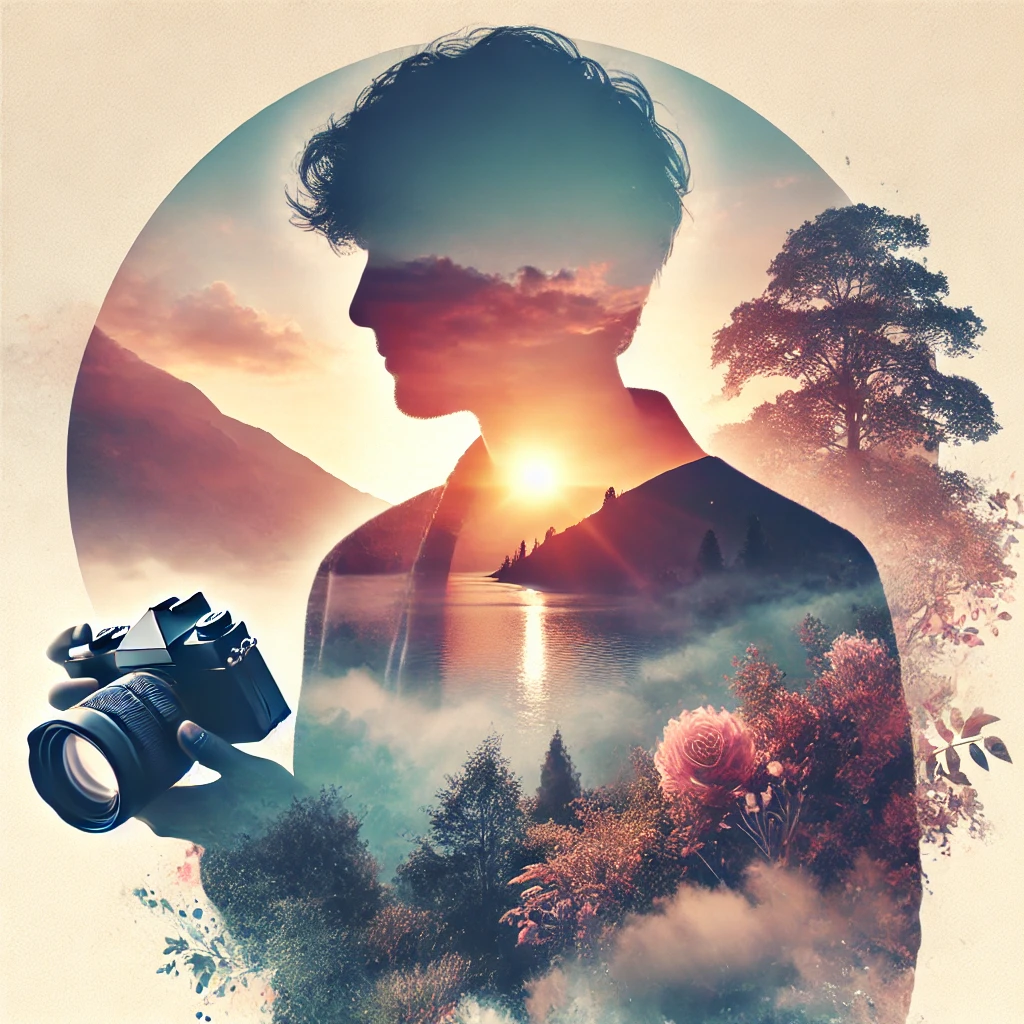Double exposure photography is a technique that blends two different images into a single composition. It creates ethereal, surreal, and artistic effects, making it a favorite among creative photographers. This article will guide you through the process of capturing and editing double exposure images, whether you use a digital camera or smartphone.
What is Double Exposure Photography?
Double exposure is the combination of two images into one frame. Traditionally, it was achieved using film cameras by exposing the same frame twice. In digital photography, this effect can be created using in-camera settings or editing software like Photoshop.
Benefits of Double Exposure Photography:
- Adds creativity and artistic expression to images.
- Creates storytelling opportunities.
- Blends nature, portraits, and textures for striking effects.
- Enhances post-processing skills.
Essential Equipment for Double Exposure Photography
To achieve the best results, you need:
- A DSLR or Mirrorless Camera with multiple exposure mode.
- A tripod for stability.
- Editing software such as Adobe Photoshop.
- A smartphone app (Snapseed, Blend Editor) for mobile double exposure effects.
Step-by-Step Guide to Capturing Double Exposure Photos
1. Choosing Your Subject
Select two images that complement each other. Common combinations include:
- A portrait and a texture (e.g., human face blended with clouds).
- A cityscape and a silhouette.
- Nature elements, such as trees merging with landscapes.
2. Using In-Camera Double Exposure Mode
Many cameras have built-in multiple exposure settings. Follow these steps:
- Navigate to Multiple Exposure Mode in your camera settings.
- Select Additive or Average blending mode.
- Take the first shot, ensuring good contrast and composition.
- Overlay the second image by aligning it carefully.
3. Editing Double Exposure Images in Photoshop
If your camera does not support in-camera multiple exposure, Photoshop can help:
- Open two images in separate layers.
- Change the blend mode of the top layer to Screen or Multiply.
- Adjust opacity and layer masks for refined blending.
- Use the Brush Tool to selectively remove unwanted areas.
4. Experimenting with Mobile Apps
For smartphone users, apps like Snapseed, PicsArt, and Blend Editor allow easy double exposure effects:
- Import two images.
- Use the Blending Tool to merge them.
- Adjust brightness, contrast, and opacity.
Creative Ideas for Double Exposure Photography
- Silhouette Blending: Take a dark silhouette against a bright background and merge it with landscapes.
- Textured Portraits: Overlay a face with natural textures like leaves or water.
- City and Nature Fusion: Combine urban structures with organic elements for contrast.
- Abstract Compositions: Use patterns and light leaks to create unique visuals.
Tips for Perfecting Double Exposure Photography
- Ensure the first image has a distinct subject with a well-lit background.
- Use high contrast images for better blending.
- Experiment with different blend modes to achieve unique effects.
- Always refine images in post-processing for a polished look.
Conclusion
Double exposure photography is a creative way to experiment with composition and storytelling. With practice and the right techniques, you can produce stunning images that captivate viewers. Whether using a DSLR, smartphone, or editing software, the possibilities are endless.

Sony Alpha a7 IV: The Ultimate Camera for Photography

Nikon Z5 Review: Is It Worth It?
-

Nikon Z9 : Game-Changer for Photography
-

Top Features of Nikon D850 That Make It Ideal for Portfolio Shoots
Sony Alpha a7 IV: The Ultimate Camera for Photography
Explore the Sony Alpha a7 IV in this complete 2025 review. Learn how its pro-level features, real-world performance, and hybrid flexibility make it the ultimate camera for photography across genres like portraits, weddings, travel, and commercial work. Table of Contents Section 1: Introduction – Why the Sony Alpha a7 IV Stands Out The Sony Alpha…
Nikon Z5 Review: Is It Worth It?
In 2025, photographers—whether hobbyists, content creators, or professionals—seek equipment that blends value, performance, and future-readiness. Enter the Nikon Z5, a full-frame mirrorless camera marketed as a gateway to high-end imaging without a flagship price tag. But how well does it hold up under real-world demands like studio shoots, weddings, landscape adventures, and lifestyle photography? In…
Nikon Z9 : Game-Changer for Photography
Discover why the Nikon Z9 is considered a true game-changer for photography. This in-depth Nikon Z9 review explores key features, real-world performance, and how it excels in professional photo shoots in 2025. Table of Contents 1. Introduction The photography world witnessed a significant shift with the launch of the Nikon Z9, a flagship mirrorless camera…
Top Features of Nikon D850 That Make It Ideal for Portfolio Shoots
Discover why the Nikon D850 is the ultimate DSLR for portfolio shoots. Explore its top features—from resolution and dynamic range to autofocus precision and workflow speed—that help photographers create stunning, high-impact images for professional portfolios. Whether you’re a portrait artist, fashion photographer, or visual storyteller, a portfolio shoot demands technical excellence, creative flexibility, and uncompromised…
Candid Moments with Canon EOS R10: Lightweight & Reliable
In the evolving world of mirrorless photography, the Canon EOS R10 stands out as a lightweight yet powerful camera tailored for real-life storytelling. Whether you’re photographing street scenes, family gatherings, weddings, or spontaneous portraits, capturing genuine emotion requires a responsive and discreet tool. This article dives deep into how the Canon EOS R10 excels in…
Bold Portraits with Canon EOS R5: Is It the Best for Work?
Studio photography has always demanded precision, artistry, and impeccable gear. As the expectations for commercial portraits, fashion campaigns, and editorial work continue to rise, the tools we use must evolve. Enter the Canon EOS R5, a camera that has stirred the professional waters with its impressive technical specs and forward-thinking design. In this comprehensive Canon…


